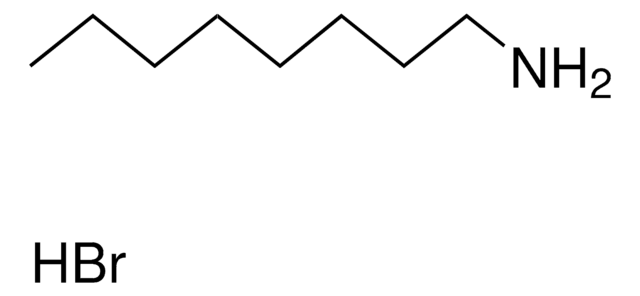913065
n-Octylammonium iodide
Greatcell Solar®
Synonym(s):
1-Octanamine, hydriodide (9CI), n-Octylammonium iodide, Greatcell Solar®, NOAI, Octylammonium iodide
Sign Into View Organizational & Contract Pricing
All Photos(1)
About This Item
Empirical Formula (Hill Notation):
C8H20IN
CAS Number:
Molecular Weight:
257.16
UNSPSC Code:
12352300
NACRES:
NA.23
Recommended Products
Related Categories
Application
Incorporating n-Octylammonium iodide into the perovskite layer can lead to improved stability of the solar cell. It helps reduce the presence of defects and grain boundaries within the perovskite film, which can enhance the long-term stability and durability of the device under operating conditions. The choice of organic cation, such as n-Octylammonium iodide, in the perovskite layer can contribute to enhancing the power conversion efficiency of the solar cell.
Organohalide based perovskites have emerged as an important class of material for solar cell applications. The variations/substitution in organohalide cations and anions is employed for the optimization of the band gap, carrier diffusion length, and power conversion efficiency of perovskites based solar cells.
Legal Information
Product of Greatcell Solar Materials Pty Ltd.
Greatcell Solar is a registered trademark of Greatcell Solar Materials Pty Ltd.
Greatcell Solar is a registered trademark of Greatcell Solar Materials Pty Ltd.
Greatcell Solar is a registered trademark of Greatcell Solar
Storage Class Code
11 - Combustible Solids
WGK
WGK 3
Flash Point(F)
Not applicable
Flash Point(C)
Not applicable
Certificates of Analysis (COA)
Search for Certificates of Analysis (COA) by entering the products Lot/Batch Number. Lot and Batch Numbers can be found on a product’s label following the words ‘Lot’ or ‘Batch’.
Already Own This Product?
Find documentation for the products that you have recently purchased in the Document Library.
Clayton J Dahlman et al.
ACS nano, 14(9), 11294-11308 (2020-08-25)
Controlling the structure of layered hybrid metal halide perovskites, such as the Ruddlesden-Popper (R-P) phases, is challenging because of their tendency to form mixtures of varying composition. Colloidal growth techniques, such as antisolvent precipitation, form dispersions with properties that match
Limeng Ni et al.
ACS nano, 11(11), 10834-10843 (2017-10-25)
Self-assembled hybrid perovskite quantum wells have attracted attention due to their tunable emission properties, ease of fabrication, and device integration. However, the dynamics of excitons in these materials, especially how they couple to phonons, remains an open question. Here, we
Qi Zhang et al.
Advanced materials (Deerfield Beach, Fla.), 30(18), e1704055-e1704055 (2018-03-27)
2D organic-inorganic hybrid perovskites (OIHPs) represent a unique class of materials with a natural quantum-well structure and quasi-2D electronic properties. Here, a versatile direct solution-based synthesis of mono- and few-layer OIHP nanosheets and a systematic study of their electronic structure
Systematic studies on chain lengths, halide species, and well thicknesses for lead halide layered perovskite thin films.
Takeoka Y, et al.
Bulletin of the Chemical Society of Japan, 79(10), 1607-1613 (2006)
Our team of scientists has experience in all areas of research including Life Science, Material Science, Chemical Synthesis, Chromatography, Analytical and many others.
Contact Technical Service








